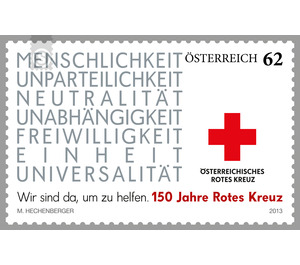150 years - Austria / II. Republic of Austria 2013 - 62 Euro Cent
Theme: Health & Human
| Country | Austria / II. Republic of Austria |
| Issue Date | 2013 |
| Face Value | 62.00 |
| Edition Issued | 400,000 |
| Printing Type | offset |
| Stamp Type | Commemorative |
| Item Type | Stamp |
| Chronological Issue Number | 2407 |
| Chronological Chapter | OOS-OE2 |
| SID | 263751 |
| In 56 Wishlists | |
No doubt, a red cross on a white background is more than just a sign: wherever you meet the emblem - be it on a Jeep in Georgia or Kenya, on an ambulance in Austria or as a sticker on a shirt - you can be sure that even in the worst horror and in the greatest need someone cares for humanity. For 150 years, the Red Cross has characterized its employees and facilities in this uniformly memorable way. Thousands of Red Cross employees work in the hot spots of the world, from Syria to Mali, Yemen, Congo and Afghanistan. The conflicts dictate long lists of tasks they carry out for the benefit of the civilians concerned and for the protection of military personnel. Some of them, such as the visitation and registration of prisoners of war, are unique powers anchored in international humanitarian law. In more than 90 countries, Red Cross employees visit prisoners of war, lead separate families, build aqueducts, distribute seed, vaccinate children, grant microcredits, secure food and drug supplies, run hospitals and health care facilities, or negotiate internationally binding agreements. Their origin was the bustle of humanity on 17 February 1863 in Geneva; At that time, five people around the businessman Henry Dunant founded the "International Committee of Aid Services for Wounded Care". As a symbol, the convinced humanists chose a simple red cross. As early as 1864, twelve states signed the first Geneva Convention for the Protection of Wounded Soldiers and Medical Personnel. 150 years later, the original idea of putting injured militants alongside injured paramedics has grown into the world's largest humanitarian movement. In addition to the International Committee of the Red Cross, National Red Cross and Red Crescent Societies provide relief from suffering in 188 countries around the world. One of the biggest challenges for the Red Cross in the complex current crises is, of course, the lack of respect for international humanitarian law, which prohibits violence against those not involved in the conflict, such as children, the wounded, the sick or prisoners. However, one thing is certain: over the years, the initially small Swiss organization became a global player whose 13,000 employees from 100 nations help in more than 90 countries. The motif of the new special stamp formulates the noble principle of the Red Cross in deliberately chosen simple design: "Humanity, impartiality, neutrality, independence, voluntariness, unity, universality. We are here to help. "


